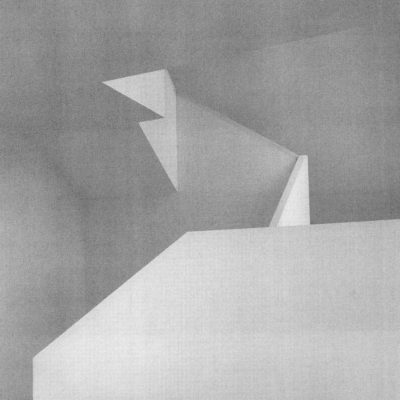Nothing is more frustrating for this reviewer than being aware of a release’s historical and technical details, yet finding the content inscrutable despite the reiteration of the listening experience. But this is exactly what is happening with Joaquín Gutiérrez Hadid’s Sûr, which I have been absorbing throughout the last days. The immediate feeling was one of sensorial moisturizing; still, whenever a genuine analysis was attempted, a thorough disconnection from materiality prevailed. This condition – call it intellectual numbness, if you will – hasn’t changed since.
Originally conceived as an on-site installation at Casa Victoria Ocampo (Buenos Aires), this work principally exploits the computerized transformation of a female voice reading a poem by Jorge Luis Borges. That voice belongs to the very Ocampo, a fundamental cultural figure in 1930s Argentina. However, you won’t locate familiar components of human utterance by searching with a lantern (except an ephemeral appearance in a track called Pour).
What you get instead is a finely crafted arrangement of baffling sonorities, halfway through processed environment and spectral/mildly percussive electronics, its skilled spatialization stroking the nerves without additional explanations. To quote curator Ezequiel Fanego, the voice is “liberated from its semantic features and reconnected with its qualities as a vibrational body”. To add a degree of puzzlement, as a final move the composer played the entire mix within the interiors of the house piano, thus triggering a different kind of “room response” informed by the instrument’s harmonic refractions.
In a nutshell, Hadid’s acoustic designing doesn’t really permit an inspection; one just needs to let it inhabit and decisively shape the resonant space around our ears. Whatever you might think after my ultimately ineffective words, forget in any case about “ambient”; a name such as Paul Schütze may be closer to an ever-vague target of stylistic comparison. At the end of the day, Sûr is an active complement to the frequencies of consciousness, the latter enabled to decode cryptic signals without mental intrusions. Therefore, receive these sounds in complete silence, letting them murmur their hidden meanings deep inside.
(toneshift.net)
From the LINEr notes (pun intended) we learn that this music was originally intended for a site-specific installation at Casa Victoria Ocampo, Buenos Aires, in 2018. During the 1930s this manor served as the headquarters of Sur – ‘a cosmopolitan and Europeanizing journal that sought to “modernize” the local artistic scene’.
The source material for this installation was a fragment of Victoria Campo reciting a poem by Jorge Luis Borges – but it is processed in such an intense way that it is not recognizable as a human voice at all, at least not until halfway into the fifth track Pour.
“By freezing, dilating and dissecting the granulated texture of the voice, it ceases to be the neutral conductor of an external meaning, unfolding its own unfathomable polysemy.”
One could argue that the main protagonist of this recording is the house itself since áfter the original installation Joaguín Gutierrez Hadid went back to play back the installation recording onto the piano in the living room of the house. “With this source material, the pieces composed at the studio were filtered by an impulse response of the “room” within the piano—a spatial setting that emulates its specific acoustical qualities.”
The result is a beautiful album that has found the right place at Richard Chartier‘s Line (Imprint) label.
I am not familiar with the current Buenos Aires’ art scene, nor do I know if (and how) it has ‘modernized’ since the 1930s with or without the help of Sur. But I dó feel that this is sound-art that probably perfectly fitted Victoria Ocampo’s original intentions.
(ambientblog.net)

